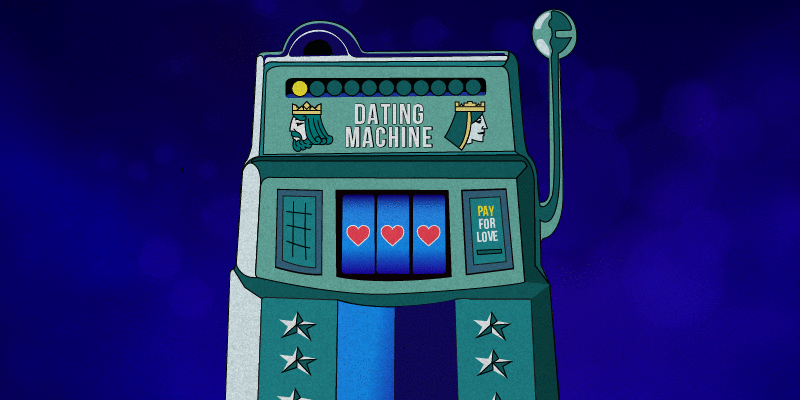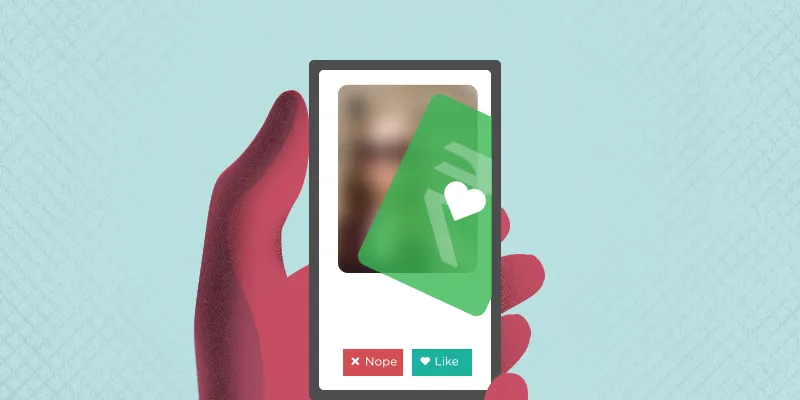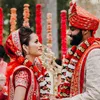How much will you pay for love on online dating apps?
Even as the number of online dating app users is expected to go up to 26.8 million by 2024, the real question is – will they pay to use the premium features offered or is it just a gamble?

(Image: Aditya Ranade)
Will you pay for love?
Anurag gives a loud throaty laugh in response to the question. Realising that the chortle was not the answer I was looking for, he whips out his iPhone. It comes alive with the apps begging for his attention.
“So you see I have subscribed to Netflix, Amazon Prime, and Spotify,” he says. After a pause, he clicks on a folder and out pop apps that are the answer to my question. From Tinder to Hinge to Bumble, you name it and it is there.
Eight months ago, besides paying monthly subscriptions for the entertainment apps, 35-year-old Anurag was also subscribed to the premium packages offered by online dating apps.
The dating apps, which otherwise follow a freemium model, also offer subscription packs to increase the users’ chances of winning themselves matches.
Today, he keeps the dating apps in a hidden folder on his iPhone. Needless to say, being a paid user has worked for him. It has been eight months since Anurag got married to one of his matches.
His statement, “I pay for food and transport (alluding to Swiggies and Olas) why not for love,” sounds logical. Yes, Indians are paying for love. And we don’t mean it any other way.
Say hello!
Just to give you an idea, the revenue in the online dating segment in India is pegged at $63 million at present, with the average revenue per user (ARPU) amounting to $2.78, according to data from Statista market analysis.
By 2024, the revenue is expected to grow at 5.2 percent resulting in a market volume of $77 million. By then, the number of online dating users is also expected to go up to 26.8 million.
Now, how many of them will pay for love can be gauged by the fact that love seems to be a high motivation for the millenials (the majority target segment of online dating apps).
According to the global dating app OkCupid, while most of their millennial users have an “unquenchable thirst for knowledge (46 percent), love is not far behind with over 30 percent men and women saying that they are still driven by the idea of true love.”
Sixty-one percent of women and 53 percent of men consider love as a true stroke of serendipity and want it to just happen to them by chance. And if it means shelling out a couple of bucks in the process to make that happen, so be it.
Statista reveals that in India “fewer people are willing to pay more for relationships. A higher number of Indians are willing to pay less for a chance for casual encounters.”
Before this appears to sound like 'heads I win, tails you lose', let’s look at the online dating landscape in India and the spending habits of its users.
While on one hand of this landscape reside casual dating global apps like Tinder, Bumble, and other copycats, on the other side are high-intent homegrown dating apps like Aisle and TrulyMadly. And casting a shadow over this dating business are the online matrimonial big daddies like Bharatmatrimony, Shaadi.com, and such.
High-intent apps are focused on relationships as the outcome while casual ones are more focused on user growth. So while the success of high-intent apps depends on female user satisfaction, casual apps optimise for male user satisfaction.
Typically, Indians between 24 and 37 years choose to spend on casual dating apps, men more so than women.
Able Joseph, who started Aisle, a high-intent dating app in 2014, says that Tier II and III towns prefer casual dating. “This may be because they know that an arranged marriage is around the corner anyway,” he adds.
Most casual apps charge less than Rs 500 for premium features, some as low as Rs 100. But according to him, high-intent apps charge more to weed out the casual daters.
The skewed female-male ratio on dating apps means that there is a scarcity of women and thus men like Anurag prefer dating apps where they offer them unlimited premium features.
Matching frenzy
For instance, , which has 5.7 million paid subscribers globally, utilises a dynamic pricing structure that offers multiple price points that may vary by region, length of subscription, recent in-app promotions, and more.
Says Tinder India Head Taru Kapoor, “The fundamental Tinder experience is free. We have a subset of members who find enough value in our premium offerings to pay for them, and this helps us continue to grow and drive innovation at Tinder.”
According to her, the global online dating company is always “testing new iterations and payment structures to provide members with increased functionality and features that best suit their needs.”
Bumble, which made its high-profile entry in India in 2018 riding on Bollywood celebrity Priyanka Chopra’s shoulders, has over 80 million global users and more than a billion first moves made globally.

(Image: YourStory)
Priti Joshi, Vice President of Strategy, Bumble, says, “Bumble India’s user base has quadrupled to surpass two million users and one of our fastest-growing user segments is Gen Z. We’ve also seen that women in India are empowered and excited to take control -- they have made the first move over six million times on our platform and are sending twice the number of messages compared to women in the rest of the world.”
According to her, 40 percent of women in India use more than one mode on Bumble. “This speaks about the power of the social network - and we're excited to continue to support men and women as they experience each of Bumble's modes - Date, BFF, and Bizz.”
Like Tinder, Bumble is a freemium app with the availability of premium features such as Bumble Boost, which lets the user see everyone who has right-swiped them, extend matches by 24 hours, and rematch with any expired connections.
Pay heed
Interestingly, even as these global giants are changing user behaviour when it comes to dating and relationships, there has been a spurt in the number of homegrown online dating apps.
Navin Honagudi, Managing Director, , one of the early believers in the online dating space in India, and who wrote the first cheque for TrulyMadly, says that this sector has seen more than 50 startups come up in the past seven years, and an equal number or more are coming up.
“There is a huge opportunity in Tier II and III towns and as long as the entrepreneurs build a strong, trusted, and verified network they are bound to see success,” he adds.
According to Navin, in the online matrimonial/dating space, the entrepreneurs need to pick their spot right and identify their niche based on market insights to build a viable product.
Today, the positioning of various relationship apps has been well established in the mind of the consumer. “On matrimonial sites, where the need is pressing, consumers have a higher propensity to pay,” he adds.

(Image courtesy: Tinder)
In an earlier conversation, Alok Mittal, Co-founder and CEO of , who was on the Board of Bharatmatrimony until four years ago, told me, “Even as I look at the Tinder generation, the interesting part is that when it comes to marriage, many older value systems have been more stable than when it comes to dating. Even as young people are finding their life partners, they are still thinking of that as a different exercise rather than finding a date for the next day. How deeply that is ingrained and how quickly that changes is a matter of time.”
And therein lies a big opportunity for homegrown dating apps to make hay while the sun shines.
Matrimony is a new category that the homegrown dating apps are creating partly by design and partly by default.
The middle ground
Says Snehil Khanor, Co-founder and CEO of , “We say find your forever by yourself. The young want to be responsible for their own marriages but do not want to go through the matrimonial sites as that leaves out the scope for exploring.”
He says the idea is to create a community of users who have the same intention but not an agenda to get married right away as it happens on matrimonial websites. “There the conversation starts with the parents, and caste and race become a priority. What we are trying to build is a curated platform of people with the same intention,” he adds.
TrulyMadly has around five million users of which three percent are paying customers. Interestingly, the app only charges its male users. Says Snehil,
“We are seeing a lot of success stories. What we have found is that it takes about two years for people to get married after meeting on TrulyMadly. Another trend we have observed is long-distance relationships, especially from Tier II and III towns.”
By paying for the premium pack, the male user unlocks features where they stand a chance to get their profile seen by 3X people. Another feature that gets unlocked is a compatibility score worked on by family counsellors and psychometric experts.
The premium pack on TrulyMadly starts with Rs 599 and goes up to as much as Rs 3,200 depending on the features unlocked and the subscription period. “Our revenue model is totally based on the subscriptions, though we have a few ads as well, but only the ones that are relevant to the community,” says Snehil, who is in the process of rebooting the business and is getting ready to raise a fresh funding round. TrulyMadly had earlier raised Rs 45 crore.
Aisle, which has so far raised around $300,000 in venture funding, clocks a revenue of Rs 90 lakh and is growing at 10 percent month on month, according to its Founder Able. It’s average revenue per paying user is Rs 1,200 with 20 percent of its revenue coming from women users. “The age group with maximum spends is between 27 and 34 years,” says Able.
According to him, young Indians who did not grow up watching western TV programming are growing on casual dating apps, especially the copycats, because they are cheaper.
“Older singles who grew up on Star World, Disney etc. are migrating to high-intent dating apps.”
Pointing out at a few more trends that entrepreneurs in the space can capitalise upon, Able says, “Urban women are being attracted by apps that have high brand value and stand for a social cause, like Bumble is for feminism. Urban men realise that women open to one-night-stands are on casual dating apps with high brand-value and not copycats. It’s a great time in terms of revenue growth for all dating apps who can get singles to actually meet offline.”
Whether the Indian user decides to swipe right to unlock the paid features or not, one thing is clear: it is a clean sweep for startups in the online dating space as long as they play the game well.









